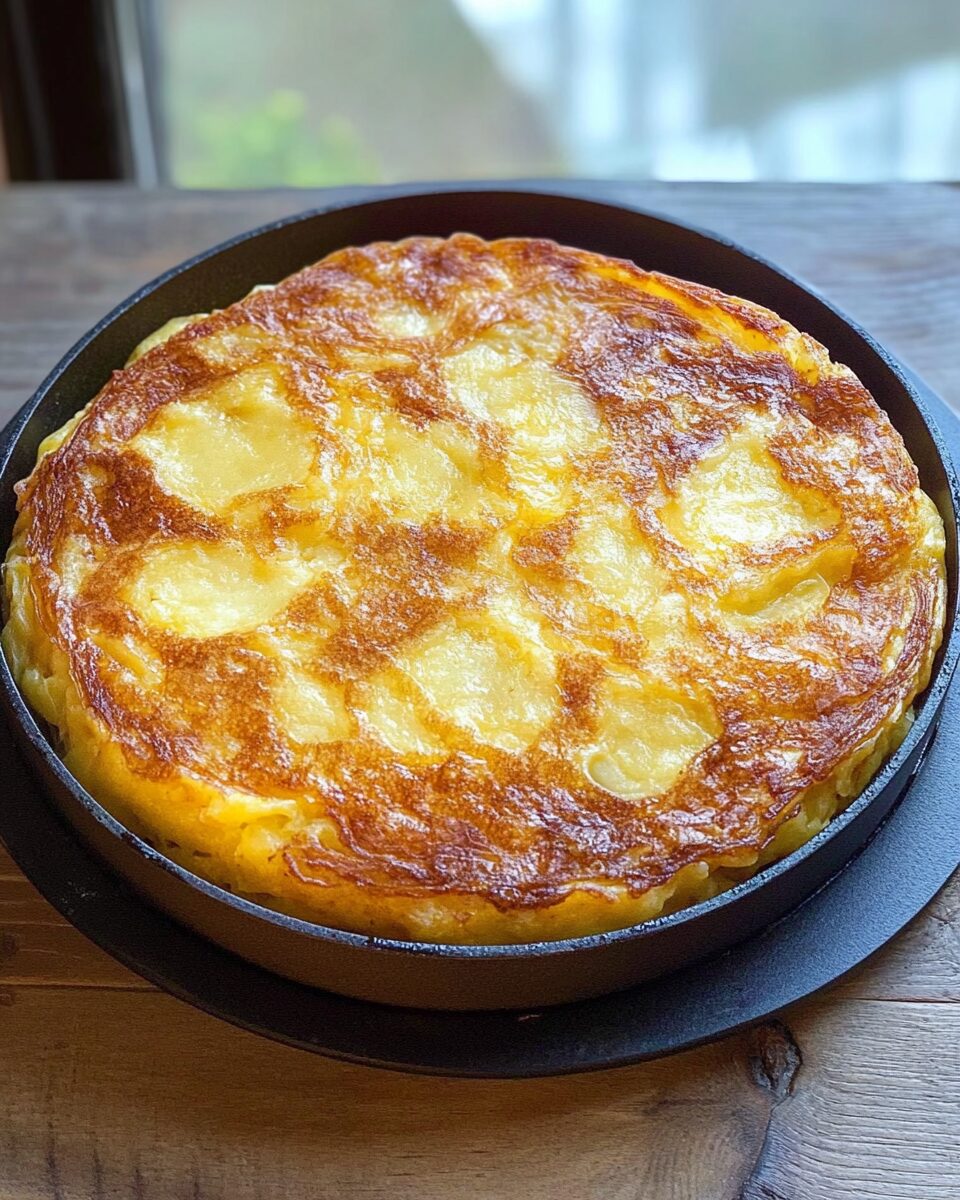The Spanish Tortilla, or Tortilla Española, is a beloved classic of Spanish cuisine, highlighting the beauty of simple ingredients cooked with care. Tender potatoes and onions meld into silky eggs, creating a savory dish that’s comforting and satisfying in every bite.
This recipe is perfect whether you’re planning a casual brunch, a tapas night, or simply want a hearty, flavorful meal that feels like a warm hug from Spain. Serve it hot, cold, or at room temperature—it’s a versatile dish that always impresses with its humble charm and rich flavors.
Full Recipe:
-
6 large eggs
-
1 1/4 pounds (about 3 medium) Yukon Gold potatoes, peeled and thinly sliced
-
1 medium yellow onion, thinly sliced
-
3/4 cup olive oil
-
Salt, to taste
-
Freshly ground black pepper, to taste
Directions:
-
Heat the olive oil in a large, non-stick skillet over medium heat.
-
Add the sliced potatoes and onions, stirring gently to coat with oil.
-
Cook slowly, stirring occasionally, until the potatoes are tender but not browned, about 20 minutes.
-
Remove the potatoes and onions with a slotted spoon and drain them well, reserving some oil.
-
In a large bowl, beat the eggs and season with salt and pepper.
-
Gently fold the cooked potatoes and onions into the eggs, mixing carefully to avoid breaking up the potatoes too much.
-
Heat a few tablespoons of the reserved oil in the skillet over medium heat.
-
Pour the egg, potato, and onion mixture into the skillet, spreading it evenly.
-
Cook until the edges start to set and the bottom is golden, about 6-8 minutes.
-
Carefully flip the tortilla onto a plate, then slide it back into the skillet to cook the other side, about 5 minutes.
-
Slide the finished tortilla onto a clean plate and let cool slightly before serving.
Prep Time: 10 minutes | Cooking Time: 30 minutes | Total Time: 40 minutes
Kcal: 270 kcal | Servings: 4 servings
Introduction to Spanish Tortilla
When one thinks of Spanish cuisine, dishes like paella, jamón ibérico, and churros might immediately come to mind. Yet, nestled among these iconic foods is the humble Spanish Tortilla — a simple yet deeply beloved dish that embodies the heart and soul of home cooking in Spain. Often referred to as “Tortilla Española” or “Tortilla de Patatas,” this traditional Spanish potato omelette showcases the magic that happens when you combine basic ingredients like potatoes, onions, eggs, and olive oil with time-honored technique and love.
The Spanish Tortilla is a staple in Spanish households, appearing everywhere from cozy family dinners to festive tapas spreads. Its texture — tender, slightly creamy potatoes enveloped in soft, savory egg — offers comfort with every bite. Whether served warm, at room temperature, or cold, its versatility makes it a beloved dish for any time of day.
The History and Cultural Significance of the Spanish Tortilla
The origins of the Spanish Tortilla date back several centuries, although its exact birth is the subject of some debate. A widely accepted legend places its creation in the 19th century, attributed to the region of Navarra during a time when inexpensive, filling foods were in high demand among peasant communities.
Initially born from necessity, the tortilla’s appeal transcended social classes due to its affordability, nutritional value, and flavor. In fact, during periods of economic hardship, the tortilla served as a vital source of sustenance for many Spanish families. It became a powerful symbol of resilience and simplicity — traits still associated with Spanish home cooking today.
Throughout the centuries, the Spanish Tortilla has evolved, but its essence remains untouched. Even now, it is a fixture in Spanish culinary culture, enjoyed not only as a main meal but also as a tapa (small plate) in the country’s famous tapas bars.
Regional Variations and Modern Twists
While the classic Spanish Tortilla uses just potatoes, onions, eggs, and olive oil, various regions of Spain have introduced their own delicious variations. Some areas prefer their tortilla without onions — a debate that has sparked friendly rivalries throughout the country. Those who include onions (known as “con cebolla”) argue that it adds a subtle sweetness and moisture that elevates the dish.
Modern adaptations often incorporate other ingredients such as red peppers, chorizo, spinach, zucchini, or even cheese, catering to diverse palates while still respecting the traditional spirit of the dish. In some innovative kitchens, mini tortillas are prepared in muffin tins or served as tortilla sandwiches, showcasing the dish’s adaptability for contemporary dining.
Vegetarian and vegan variations have also grown popular, using chickpea flour and plant-based substitutes for eggs, allowing more people to enjoy the comforting flavors of this classic Spanish recipe.
The Art of Achieving the Perfect Spanish Tortilla
Mastering the Spanish Tortilla might seem simple, but it requires attention to detail, patience, and a touch of intuition. One of the most critical elements is the way the potatoes are cooked. Rather than frying them to crispiness, they are gently simmered in olive oil — a technique known as “confiting.” This method tenderizes the potatoes without browning, resulting in the tortilla’s signature soft, melting texture.
Another vital factor is achieving the right consistency for the eggs. A classic Spanish tortilla can range from slightly runny (jugosa) to fully set and firm, depending on personal preference. Traditionalists often prefer a slightly moist interior that oozes slightly when sliced.
Flipping the tortilla is another test of skill. The entire partially cooked tortilla is slid onto a plate, flipped upside down, and then gently returned to the pan to cook the other side — a delicate maneuver that speaks to the culinary craftsmanship behind this seemingly simple dish.
Serving and Enjoying Spanish Tortilla
One of the great joys of the Spanish Tortilla is its flexibility. It can be the centerpiece of a hearty breakfast, a quick lunch, a satisfying dinner, or a flavorful addition to a tapas spread. Spaniards often enjoy it as a bocadillo — a sandwich stuffed with a thick slice of tortilla nestled inside a crusty baguette. This humble sandwich is a beloved snack found in cafes and roadside stops across Spain.
The tortilla can be served warm, but it is just as delicious at room temperature, making it an ideal option for picnics, potlucks, and casual gatherings. A simple green salad, a dollop of aioli, or some marinated olives complement the tortilla beautifully, enhancing its rustic charm.
As part of a tapas menu, small wedges of tortilla provide a comforting balance to bolder flavors like spicy chorizo, pickled anchovies, or rich cheeses. It is often presented alongside a glass of Rioja or a crisp Spanish cider, celebrating the deep culinary traditions of Spain.
Common Mistakes to Avoid
While the Spanish Tortilla is simple in ingredients, there are a few common mistakes that can prevent it from reaching its full potential:
-
Overcooking the Potatoes: Potatoes should be tender, not crispy or browned.
-
Using Too High Heat: Cooking at too high a temperature can cause the tortilla to burn or dry out.
-
Not Seasoning Properly: Don’t be afraid to add a good pinch of salt and pepper — it brings out the flavor of the humble ingredients.
-
Flipping Too Early or Too Late: Timing the flip correctly ensures a golden, intact tortilla without sticking or breaking.
-
Overcrowding the Pan: Using a pan that’s too small for the amount of mixture can prevent even cooking.
Paying attention to these details can be the difference between a good tortilla and an extraordinary one.
Why You Should Make Spanish Tortilla at Home
Making Spanish Tortilla at home is a rewarding culinary experience. It teaches the importance of patience, control over heat, and respect for ingredients. It’s an excellent recipe for beginner cooks who want to build confidence and for seasoned chefs who appreciate the nuances of perfecting a timeless dish.
Moreover, because it requires only a handful of ingredients, it’s budget-friendly and accessible. Whether you’re preparing it for your family, impressing friends at a gathering, or enjoying a quiet meal on your own, Spanish Tortilla delivers hearty satisfaction with every bite.
In an age where elaborate dishes often dominate social media, the Spanish Tortilla stands as a refreshing reminder that simplicity and authenticity never go out of style.
Conclusion
The Spanish Tortilla is far more than just a potato omelette — it is a culinary emblem of Spain’s rich history, regional diversity, and passion for honest, soulful cooking. It proves that the most memorable dishes are not necessarily the most complex but those made with care, tradition, and high-quality ingredients.
Whether you savor it as part of a tapas spread, tucked into a crusty sandwich, or served as the star of a humble dinner, the Spanish Tortilla brings a taste of Spain to your table with every tender, savory bite. It invites cooks of all skill levels to embrace the beauty of simplicity, respect time-honored techniques, and most importantly, to share delicious food with loved ones — just as Spaniards have done for generations.






